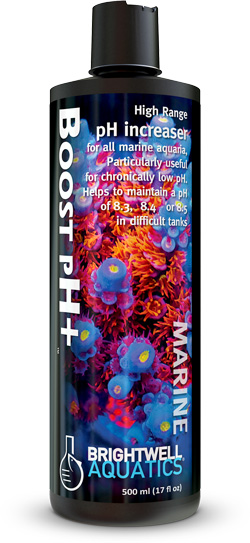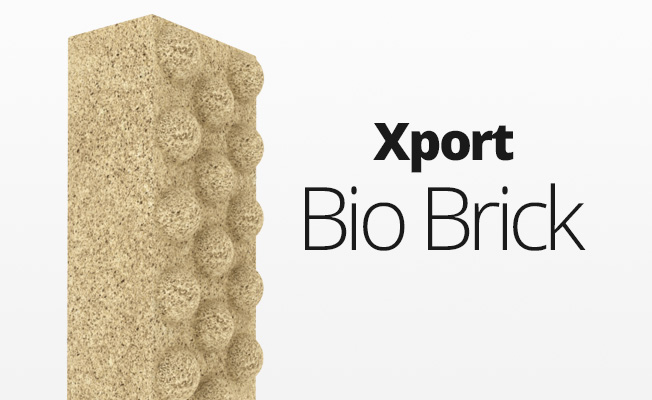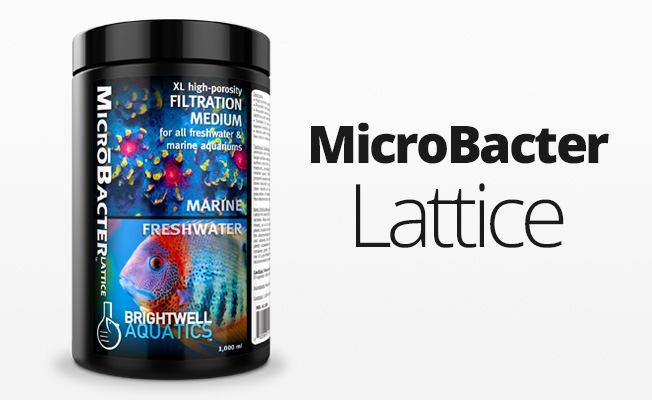
Boost pH+
High range pH increaser for all marine and reef aquaria, Helps in maintaining a pH of 8.3, 8.4 or 8.5 in difficult tanks
Overview
- Increases pH in marine and reef aquaria
- Works with buffers and alkalinity products to increase pH to desirable 8,3, 8.4 or 8.5 levels
- Thought to assist coral growth. Anecdotal evidence shows higher pH allows increased growth rate in new frags and mother colonies in coral growout facilities
Sizes
250ml | 500ml | 1L | 2L | 4L
Technical Overview
FIRST, please read this entire page! Boost pH is designed to be used as needed. Although it can be dosed, there can be difficulties with dosing, if you don't understand the pitfalls (see Pitfalls section below). pH is a measurement of the acidity of a solution, such as aquarium water. The pH of natural seawater ranges from approximately 8.2 - 8.4, however maintaining pH in the range of 8.4 - 8.5 on a daily basis is thought to have a positive effect on captive marine organism growth rate, primarily in stony corals. Also it may help prevent bleaching, boost immune response and assist in coloration. To maintain a stable pH within the desired range, the alkalinity should first be maintained above 7.0 dKH (2.5 meq/L). Aquaria with low circulation at the water’s surface, or in which a CO2-injected calcium reactor is being employed, or which are placed in an enclosed room with human and animal inhabitants (giving off CO2 into the air), often have a depressed pH due to carbon dioxide build up. In an aquarium which has a proper alkalinity as stated above, Boost pH+, along with other measures, such as providing outside air to the skimmer intake and other CO2 control methods, can help to bring pH in the aquarium back into a higher desired range. Use as directed and do not exceed a pH value of 8.5, because pH at 8.6 or higher may be stressful and/or damaging to sensitive aquarium inhabitants. Additionally, changes to pH should be made very gradually, again to avoid stressing aquarium inhabitants. See suggestions for adjusting alkalinity below. It is not unusual for pH to fluctuate throughout the course of 24-hours between seemingly wide-ranging values (i.e. lower at night higher during the middle of the day); this is a natural occurrence that is caused by changes in the rates of photosynthesis between dark and light periods. If pH levels are seen to be constantly below the desired level and alkalinity is within the proper range, then the addition of Boost pH+, this product, may be helpful. If comparing pH to determine how Boost pH+ is working, measure at the same time every day.
Instructions & Guidelines
Causes burns, Do not get into your eyes! Keep Locked Away out of reach of children. First read warning and follow safety recommendations while using or storing this product! Wear suitable gloves and eye/face protection during use. If you get the product on your skin or eyes, follow the instructions on the bottle and rinse with copious amounts of water and seek professional medical help, IMMEDIATELY. When used as directed, this product safely raises pH. You should first use other products to adjust alkalinity over 7.0 dKH. Although Boost pH+ will raise the alkalinity, Do not attempt to use Boost pH+ on systems with low alkalinity or to use it to just raise alkalinity. It is not designed for that. First, determine the alkalinity in the aquarium using an accurate test kit (recommended) or recently-calibrated meter before using this product (see section below on pitfalls prior to use). If the alkalinity is below 7.0 dKH or 2.5 meq/L, adjust it first using Brightwell Aquatics’ pH+ or Alkalin8.3 or Alkalin8.3-P (powder) or Reef Code B or Reef Code BP (all of these products raise both the alkalinity and pH and then ideally allow 24-hours to elapse before re-testing alkalinity and pH, then adjust pH upward, if needed, by adding Boost pH+ as directed below. The dosage required will vary significantly based on a number of factors, but as a general estimate, 2.0 ml of Boost pH+ will raise the pH of 10 US gallons by about .1 to .3 pH, depending on the amount of CO2 in the system and the alkalinity.
Directions
First adjust the alkalinity to above 7.0 (2.5 meq/L) as described above using Brightwell Aquatics’ pH+ or Alkalin8.3 or Alkalin8.3-P(powder) or Reef Code B or Reef Code BP as directed on their bottles. To raise pH further, add 2.0 ml of Boost pH+ (this product) per 10 US gallons in a high flow area such as a pump intake or a power head exhaust. pH will generally stabilize within 10 minutes following product use, Re-measure pH and dose again, if necessary. Do not add more than 10 ml per 10 gallons per day! Livestock should not be subjected to a change in pH of more than 0.2 per 24-hour period, so do not overdose Boost pH+. Repeat as needed to attain desired pH value. It is recommended that pH be maintained within a range of +/-0.2 at all times.
Pitfalls
Boost pH+ is an excellent but somewhat unusual product, in that it is designed to adjust only the high end of your normal buffering system, not do the entire work of a complete buffer. It has to be designed this way because a regular buffer cannot readily be adjusted to go higher than about 8.3 pH. Boost pH+ will raise alkalinity also, but do not use it for that purpose. A product like Brightwell Aquatics’ pH+ or Alkalin8.3 or Alkalin8.3-P (powder) or Reef Code B or Reef Code BP (powder) must first be used, or the marine salt you are using must be properly buffered, so that the alkalinity is in normal seawater ranges. If the alkalinity is too low, Boost pH+ cannot work properly, and you will be disappointed. Of course, it is dangerous to operate a marine system below 7.0 dKH and most hobbyists understand this. Systems with low alkalinity are subject to catastrophically rapid drops in pH, in much the same way that bank accounts that have low balances are subject to sudden overdrafts. In this age of the internet where seemingly everyone with a computer is an expert, there are voices that say that you can operate your tank at 7.0 or even lower (these are individuals that likely like to "roll the dice" at a casino too). Of course a marine aquarium will operate just fine at the low dKH until there is an upset and then everything dies. The moral of this story is pay attention to alkalinity and keep it above 7.0 dKH, preferably 7.5 or higher.
Perhaps the worst mistake you can make would be to hook up a large bottle of Boost pH+ to a doser on the first day you use it - without understanding how it works or the effect it will have on your system. And yes, we have had customers who did this, believe it or not. This is particularly true if the system has low or borderline low alkalinity. In that case the pH electrode would call for large amounts of Boost pH+ and the result would be an overdose of the system. pH probes can be notoriously inaccurate when they are not maintained properly nor calibrated properly. This exacerbates the problem. We suggest that you use a regular test kit and manually dose until you see how the product effects your system.
The following is a list of mistakes that could cause Boost pH+ not to give you the performance you desire:
- If you don't adjust the alkalinity to at least 7.0 dKH and maintain that level. If you don't properly adjust alkalinity with a true buffer, you could observe the need for excessive amounts of Boost pH+, excessive cloudiness of the aquarium or the product will not perform as advertised. We also recommend that you use a true buffer, such as Brightwell Aquatics’ pH+ or Alkalin8.3 or Alkalin8.3 (powder) or Reef Code B or Reef Code BP to increase the alkalinity, instead of some of the single component so called "alkalinity" supplements that only contain sodium carbonate. You could save money from using them, but they are not really bargains when you factor in the instability in your aquarium that they cannot overcome. True buffers have multiple ingredients blended to provide tighter control over pH swings and the relative safety from crashes. True buffers regulate pH besides providing alkalinity. Sodium carbonate alone does a poor job of regulating pH.
- pH probes are a problem! Most pH probes will last less than a year in an aquarium, many about six months. They are not really designed to be used with the plethora of bacteria and particulate matter that exist in an aquarium. Bacterial slimes, calcium deposits and other coatings build up on their surface rendering them slow, sluggish, or incorrect. Many hobbyists think their probe is working when it is not. A pH probe must be cleaned with a properly designed cleaning fluid to remove deposits and calibrated regularly (several times a week). It also needs to be stored in a specifically prepared storage solution, when not in use. Using Boost pH+ to try to raise pH with an incorrectly reading probe is a recipe for difficulty. The first thing you might notice would be cloudiness. If you see cloudiness, stop and check your pH and alkalinity with a test kit. Test kits are typically much more reliable than electrodes, in an aquarium environment.
- If you set up Boost pH+ on a doser prior to first using it on the system and understanding how it interacts with alkalinity on your particular tank, you are asking for trouble. Boost pH+ can be dosed on systems that have pH controllers (as long as the alkalinity remains above 7.0 dKH), but it must be dosed based on pH and not based on alkalinity. You should take time to see how it interacts. Go slow. Overuse of Boost pH+ can raise the pH too high if you don't measure and pay attention. Our true buffers, Alkalin8.3 or Alkalin8.3-P, can be overused without much consequences, but Boost pH+ should not be. True buffers will stop at a pH of about 8.3. This is not true of Boost pH+, because it is not a buffer. If you continue to add Boost pH+ to try to raise alkalinity, it could continue to raise the pH to even dangerous levels in much the same way as continuing to press the accelerator on your car will increase the speed past the speed limit. This isn't likely, but it could happen with gross neglect. Adding Boost pH+ manually based on pH tests is the best method, until you understand how it works.
- Signs that you may be overdosing Boost pH+ are cloudiness in the aquarium, or an increase in alkalinity. If Boost pH+ is increasing your alkalinity, you may be adding too much or too fast or you need to take other measures, such as installing a CO2 scrubber or providing outside air to your skimmer.
Warning: Contains caustic sodium and potassium hydroxides in a proprietary base; Causes burns. Store Locked Away. Keep out of reach of children. Wear suitable gloves and eye/face protection during use. Harmful if swallowed. If swallowed: Do not induce vomiting. First rinse mouth thoroughly, then give water, call a poison control center and get medical attention immediately. Causes severe eye and skin irritation. If in eyes, remove any contact lenses, flush with water for 15 minutes IMMEDIATELY, if irritation persists, get medical attention. If on skin, remove contaminated clothes, wash skin thoroughly with soap and water for 5 to 10 minutes. Wash clothes. Seek medical help! Not for human consumption.


